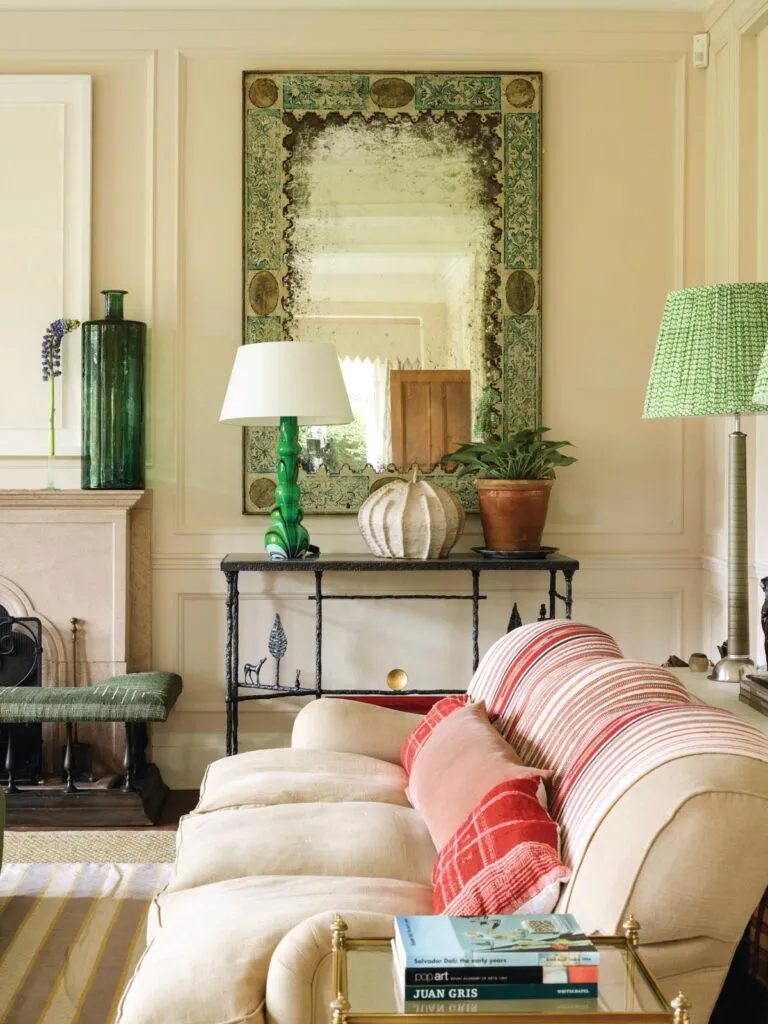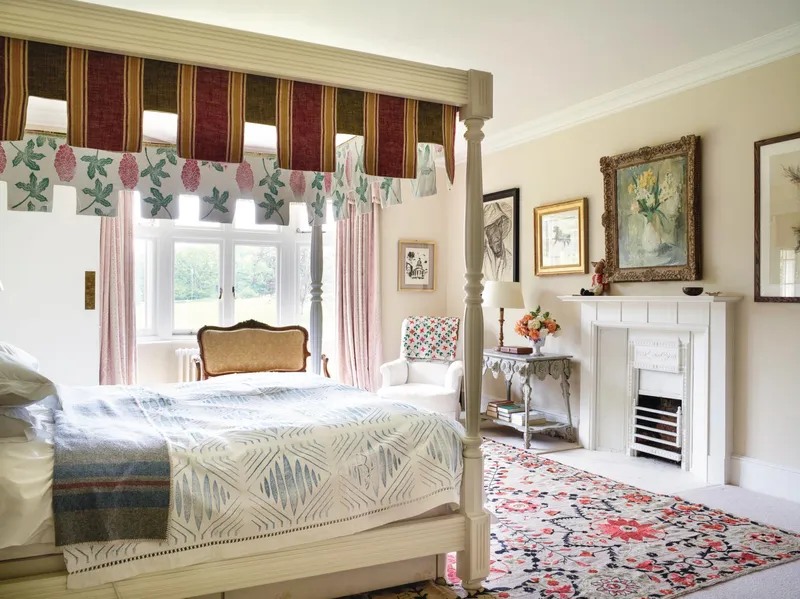There’s nothing like a budget to quicken the creative pulse, as Speronella Marsh well knows. Faced with the task of restoring her home, a red-brick manor framed by low-forested Shropshire hills, which used to belong to her husband Ben’s parents, one of the first things she did was count the windows.
There are 94 – and all of them needed new curtains to replace the sun-scorched chintzes and silks that had been installed by Ben’s grandparents in the 1950s.
Designer fabrics were out of the question. So Speronella decided to make her own. ‘For years I’d been hoarding antique French sheets that I’d found in markets. I realised they’d make ideal curtain material,’ she says.
The texture of the linen, she explains, lent itself to block-printing, which she mastered by enrolling on a workshop at the Chelsea Physic Garden. The dining table became a workbench strewn with sketchpads and brushes. As the prints emerged, friends took note of the painterly designs – acorns, fluttering seaweed – in clear, fresh colours. Orders trickled in and a business began.
‘Necessity is a good thing because it forces you to be creative. We had so much work to do that
I had to be economical,’ she says. It is a theme that runs throughout their home. Jolly, junk-shop oils, accumulated since her 20s when a dealer allowed her to pay in instalments, jostle for space in corridors where the restored parquet floors glow in spring sunshine.
No two rooms are alike… one is powder blue, another luminous yellow, and toiles collide with stripes in a joyful pot pourri of old and new.
You might also like a vibrant, colourful Edwardian home
In her previous career, Speronella worked for garden designer Tom Stuart-Smith and she has an instinct for colour and form. Creating a moodboard wasn’t for this resourceful Italian. The look here is artistic and expressive: ‘There’s always one thing that inspires me and then everything falls into place,’ she says.
‘Handsome, not beautiful’ is how she describes the property that Ben, an entrepreneur, inherited in 2013. Dating from 1840, the gables and stone-framed bays give it the benevolent air of a theological college. It was Ben’s grandfather, the managing director of Marsh & Baxter, a Midlands firm famed for its sausages and pork pies, who bought the house in 1950. Ben’s father, who moved here in the mid-1990s, spent his latter years here alone.
The two-storey house has 27 rooms. ‘So, sensibly, he lived the life of an English-country gentleman in three rooms,’ she says. Meanwhile, the house slid into a state of benign neglect. ‘Despite that, Ben has very happy memories of spending time here as a child,’ says Speronella. ‘Our task was to make it a lively family home again.’
For the couple, who have four children between them from previous marriages, it was important that the house had a relaxed, communal living space. With input from an architect, they began by tackling the Downton-ish warren of staff quarters on the ground floor.
Down came the light-guzzling walls: in their place, the bright, open-plan kitchen, dining and sitting area. The catalyst for the kitchen was nearby Ironbridge, crucible of the Industrial Revolution: ‘I wanted this space to have a utilitarian, factory-like feel,’ she says.
Speronella worked with local builders to design the glazed metal doors that open onto the kitchen. The tomato-red dresser, a mix of wood and metal, was ‘a feat of engineering’. But elsewhere, thrift prevails. A set of ‘boring’ chairs was reinvented with covers designed by Speronella; the bar stools were a street-stall steal: ‘Much to my daughter’s embarrassment, I bargained the price down,’ she says.
You might also like a colourful 1970s house in London
During Ben’s childhood, there were 12 bedrooms, two bathrooms, ‘and lots of kettles bubbling on the Aga’. That imbalance has been redressed. There are now six bathrooms, each with its own character. One is painted in a vivid yellow gloss. In another bathroom, Speronella’s collection of ‘sailor’s valentines’ – shell mosaics in glass domes – dance across a leaf-green Molly Mahon wallpaper.
Heirlooms, which were shared between the two siblings, have been revived too; one armchair was reclad in an Ikea bedspread. ‘It’s a lesson I’ve tried to teach my children: spend on important things, cheat on the rest. Junk shops crop up a lot in my conversations.’
Which brings us back to the subject of those antique fabrics, stashed in drawers for years, and now reborn as headboards and valances. Speronella’s ‘local heroes’, Ludlow Curtain Co, whipped up blinds from tablecloths and made curtains from blankets bought at The Cloth Shop in London. Inevitably, the house has become a laboratory for Speronella’s own designs.
Nowadays, she works from a large, double-height studio nearby, where freshly printed fabrics are pegged up to dry on long washing lines. Her company, Speronella Marsh Ltd, is thriving, but she’s happy that this is still a highly ‘personal’ business, rooted – as she puts it – ‘in all the things I like best’.
More homes from Homes & Antiques
- A 16th-century home filled with pattern and colour
- A colourful Edwardian home inspired by Florence
- Explore the eclectic interiors of Wardington Manor
- Sarah-Jane Axelby's art-filled 18th-century barn conversion
Sign up to our weekly newsletter to enjoy more H&A content delivered to your inbox.













